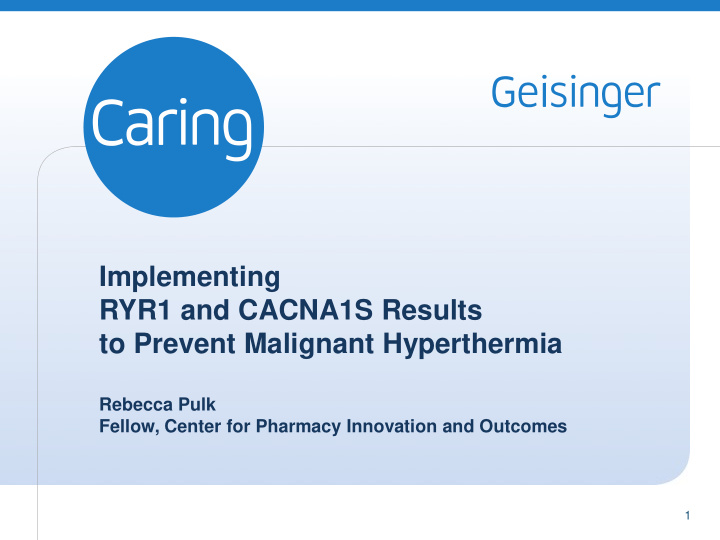



Implementing RYR1 and CACNA1S Results to Prevent Malignant Hyperthermia Rebecca Pulk Fellow, Center for Pharmacy Innovation and Outcomes 1
Outline 1. Malignant Hyperthermia: Genes and Background 2. Geisinger MyCode Implementation of MHS Results 3. Discuss Proposed Implementation Guides for Upcoming CPIC Guideline 2
Malignant Hyperthermia: Genes and Background 3
Malignant Hyperthermia Susceptibility Malignant Hyperthermia Susceptibility (MHS) is a rare autosomal dominant trait associated with mutations in RYR1 and CACNA1S 4
RYR1: Ryanodine Receptor – Type 1 • Calcium Channel – sarcoplasmic reticulum • Regulates release of stored calcium from sarcoplasmic reticulum • Involved in muscle contraction DuPont Crop Protection Promotional Material 5
CACNA1S: Calcium Voltage-Gated Channel subunit alpha 1S • L-type Calcium Channel – skeletal muscle cell surface • Upstream activator of RYR1 channels • Involved in muscle contraction Can J Anaesth, Yamakage M, Namiki A, 2002 6
Malignant Hyperthermia Susceptibility Malignant Hyperthermia Susceptibility (MHS) is a rare autosomal dominant trait associated with mutations in RYR1 and CACNA1S MH is a rare, life-threatening hypercatabolic state that is usually triggered by exposure to certain drugs used for general anesthesia or intubations Signs / Symptoms: muscle rigidity, ↑ CO 2 production, very high • temperature, ↑ HR, ↑ RR, mixed acidosis, rhabdomyolysis • Occurs in 1 in 5,000 to 50,000 instances • Mortality rates range from 6.5% to 16.9% • Can manifest up to 24 hours after exposure • Antidote / Treatment = Dantrolene (muscle relaxant) • continual infusion (36 vials / 70kg pat) 7
Malignant Hyperthermia Susceptibility Malignant Hyperthermia Susceptibility (MHS) is a rare autosomal dominant trait associated with mutations in RYR1 and CACNA1S MH is a rare, life-threatening hypercatabolic state that is usually triggered by exposure to certain drugs used for general anesthesia or intubations Signs / Symptoms: muscle rigidity, ↑ CO 2 production, very high • temperature, ↑ HR, ↑ RR, mixed acidosis, rhabdomyolysis • Occurs in 1 in 5,000 to 50,000 instances • Mortality rates range from 6.5% to 16.9% • Can manifest up to 24 hours after exposure • Antidote / Treatment = Dantrolene (muscle relaxant) • continual infusion (36 vials / 70kg pat) Not all patients with MH are found to harbor a causative MHS mutation EMHG – Currently lists 42 Diagnostic MHS Mutations 8
Malignant Hyperthermia Triggering Agents MHAUS – Malignant Hyperthermia Association of the United States 9
Challenges of Implementing MH Markers from a Pharmacogenomics Framework Orders for triggering agents generally do not go through standard pharmacy work flows Triggering agents may be used in an emergent situation during which a patient may not be responsive 10
Geisinger MyCode & Implementation of MHS Results 11
Geisinger MyCode March MyCode Scorecard 12
Geisinger MyCode March Genomic Screening & Counseling Update 13
Geisinger MH Marker Implementation – Problem List Documentation For patients with personal or family history of Malignant Hyperthermia – Documentation as MH condition in problem list Example ICD-10 Code: T88.3XXA Malignant Hyperthermia Allows for MediSpan alerting based on diagnosis code For others who have not had a personal or family history of an MH event: Document genetic finding as a monoallelic mutation with notation of specific variant Example ICD-10 Code: Z15.89; Monoallelic Mutation of RYR1 Working on a back end solution to link our standardized MyCode mutation documentation to this back end alerting 14
Geisinger MH Marker Implementation – “Allergy” Documentation • Halothane (most cross reactive via Epic alerts) • Succinylcholine Analogous to abacavir suggestions in the Guidelines for the Use of Antiretroviral Agents • Same limitations / drawbacks persist Working on “locking” these allergy field entries from editing 15
Geisinger Anesthesia Evaluation 16
Proposed Implementation Guides for Upcoming RYR1 / CACNA1S CPIC Guideline 17
RYR1 / CACNA1S Guideline Draft Implementation Text 18
RYR1 / CACNA1S Guideline Proposed Workflow, Clinical Implementation Refer patient to genetic counselor for explanation of results and to initiate cascade testing 19
RYR1 / CACNA1S Guideline Proposed Workflow, Point of Care 20
Integration into Clinical Workflows Workflow Goal of Intervention Explain influence of genetics on anesthesia Pre-op Assessment outcomes. Inform anesthetic use within the operating suite in OR Suite / Anesthesia Module of EHR real time Post-op Observation Inform the care of patients following anesthesia Identify patients with priority results to raise Inpatient Admission awareness of MHS among staff caring for patient Alert providers to MHS following exposure to Emergency Intubation succinylcholine to guide patient monitoring Inform of new result and potential role for genetic Primary Care counseling 21
Questions? 22
Recommend
More recommend